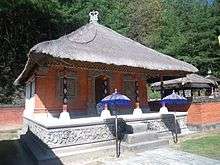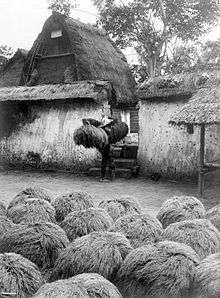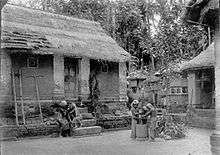Balinese traditional house

Balinese traditional house refers to the traditional vernacular house of Balinese people in Bali, Indonesia. The Balinese traditional house follows a strict ancient architectural guide which is a product of a blend of Hindu and Buddhist beliefs, fused with Austronesian animism, resulting in a house that is "in harmony" with the law of the cosmos of Balinese Hinduism.[1]
Orientation with the universe
As most traditional houses in Indonesia, spatial orientation and hierarchy are crucial considerations in Balinese architecture. The concept is based on the Hindu dharma principle: every objects in the universe is conceived as having an ideal location; this must be correctly aligned at all time in order to achieve harmony with the universe, and thus moksha – the point of liberation where a human achieves a perfect state of being – can be achieved. The placement of objects in Balinese architecture naturally plays an important role to achieve this.[1]
The principle of Balinese architecture — such as the proper size, location, and alignment of building types — is written in the Asta Kosala Kosali. The Asta Kosala Kosali are eight guidelines for architectural designs originally inscribed in ancient Javanese on a lontar (palm-leaf manuscript). According to the Asta Kosala Kosali, the universe is divided in three: buhr (underworld, realm of the demons), buwah (human realm), and swah (heaven, realm of the gods). This cosmic division is reflected in the geography of Bali: the central mountainous area (especially Mount Agung) is seen as the abode of the gods, while the sea is associated with malevolent spirits; the in between coastal plains and foothills represent the human realm.[1]
This hierarchy of realm is reflected in the Balinese cardinal direction. There are two main cardinal directions of Balinese universe: kaja and kelod. Kaja means "to the mountain" (Mount Agung) and refers to anything that is higher or sacred. Kelod means "to the sea" (abode of the demons) and indicates low and profane places. As most of Bali's population live to the south of Mount Agung, the main cardinal direction corresponds to a north-south axis running between the central mountain range (Mount Agung in particular) and the sea; however this can be different with the northern Bali Aga. The secondary directions of Balinese cardinal direction are kangin (where the sun rises, East) and kauh (where the sun sets, West), in this instance kangin is associated with life, and therefore sacred, while the kauh is identified with death and is considered profane. Thus the northeast (kaja kangin) is regarded as the most auspicious direction where family shrines are built, while the southwest (kelod kauh) is the most impure. This cardinal direction concept plays important roles in organizing many aspect of Balinese culture[2] including a Balinese house layout.[1]
Other orientation concept is also used. The Balinese compass (nawa-sanga) stems from the four cardinal direction, their intermediaries and the central area. Each point is linked to a particular Hindu deity and has symbolic ritual associations, such as corresponding numbers, colors, magical syllables, and mystical attributes.[1]
The symbolism also includes metaphorical representation of the compound and its various structures in terms of the human body. Thus, the family shrine is identified with the head; the sleeping quarters and pavilion for receiving guests, with the arms; the central courtyard with the navel; the hearth with the sexual organs; the kitchen and lumbung with legs and feet; and the refuse pit in the backyard with the anus.[1] The Traditional Balinese House museum in Tabanan is a good example of a typical compound.
The house compound

Similar with Javanese houses, Balinese house is build within a compound surrounded by wall of whitewashed mud or brick, depending on the wealth of the owner. Different with the Javanese residential compound however, the Balinese residential compound is dominated with pavilions (bale) which surround a central courtyard (natah). Different architectural elements within the compound are laid out according to Balinese conception of the sacred and profane within the cardinal points.[1]
Traditionally, the Balinese compound appears to lack the adequate provision for sleeping, eating and bathing of the modern Western culture. All buildings within a Balinese compound lack wall; in the most basic house compound, the only pavilion building that is enclosed with walls is the pavilion where the head of the family sleeps. The rest of the family member sleep in an open pavilion. Pavilions are often wall-less, erected over a low plinth, and surmounted by a clay pantiles or thatched roof, which is supported by a timber or bamboo frame depending on wealth of the owner. The wall, if erected, only constitutes a screen to provide privacy and not a load-bearing structure.[3] Each building in a house compound is identified with a certain cardinal direction, body organ, color and deity; depending on its placement.[3]
When a son of the family marries, his wife usually moves into his compound, so a compound is frequently a place for extended families, each with their own sleeping quarters, but otherwise sharing the facilities. Domestic activities take place outside or in the pavilion. Traditionally there is no bathing facility in a Balinese compound as people take their bath in public bathing pools.[4]
Central courtyard
The central courtyard (natah), located in the center, is identified metaphorically with the navel. It is basically a packed earth central courtyard which is always kept free of vegetation except for a few ornamental flowers or decorative kamboja trees.[1] It is the symbolic center of the domestic microcosm.
Family shrine

The family shrine is the most sacred area of the compound, located in the most auspicious northeast (kaja-kangin) corner of a Balinese house compound. It is identified metaphorically with the head.[1] The area of the family shrine is always enclosed within a sacred enclosure (pamerajan). Inside the family shrine area are shrines dedicated to various Hindu gods (e.g. Surya, Saraswati), nature spirits (Sridevi, Ibu Pertiwi), and family ancestors.[5] The most important shrines is the sanggah kemulan, a shrine containing three compartments dedicated to the Hindu trimurti of Brahma, Vishnu and Shiva. The sanggah kemulan is a simple, house-like, wooden structure raised on pillars and standing on a column made of brick or sandstone. Sanggah kemulan is naturally located on the most sacred corner of the family shrine compound, the kaja-kangin corner. In Balinese Hindu religion, Brahma is also associated with male ancestors of the household, while Vishnu is with female ancestors. When a Balinese man marries, he should build one of these shrines.[5]} The family shrine area is not the only place for shrines. Other shrines, e.g. the sanggah pengijeng karang ("house-protecting shrine"), is traditionally positioned in the northwest (kaja-kauh) side of the house compound, to the west of the main pavilion.
Pavilions
Balinese pavilions (bale) can be identified with rooms in the western-style houses: each pavilion has its own different function. The Balinese people classified the pavilions according to the number of posts used in their construction. A four-posts pavilion is known as bale sakepat (Balinese "four-post pavilion"), a six-posts is known as bale sakenam ("six-post pavilion"), and so on.[6]} The Balinese also classified the pavilion according to its position within the compound: a pavilion in the east (kangin) side of the compound is known as bale dangin ("east pavilion"), and so on.
The most important pavilion in a Balinese house compound is the pavilion of the head of the household, known as bale daja ("north pavilion"), because it is located on the north (kaja) side of the house compound. It is also known as bale meten (Balinese "sleeping pavilion"). The pavilion is the main sleeping room of the head of the household. It is often the only enclosed or walled pavilion within the house compound, and so it is also used to store family heirlooms. Bale daja is also the only pavilion with pointed roof, others being hip-roofed; a pointed roof is usually associated with sacred structure and is also used in the family shrines structure. Being the only place where privacy is available, the bale daja can be used for the newly weds; during the occasion, the head of the family will may move out temporarily.
Other pavilions in a Balinese house compound are bale sakepat ("four post pavilion") or bale dangin ("east pavilion"), a pavilion with four posts and located in the east side of the house compound. Bale sakepat is traditionally reserved for the head of the other extended families living in the compound (usually brothers) or for holding important ceremonies (e.g. marriage or tooth-filing).[7] The pavilion for receiving guests, the bale tiang sanga ("nine post pavilion") or bale dauh ("west pavilion"), is situated in the west (kauh) side of the compound. The bale sakenam ("six post pavilion") or bale delod ("south pavilion") is located at the southern (kelod) end of the courtyard; a utilitarian pavilion which is traditionally used for women to do their weaving.[3]
Utilitarian structures

The kitchen (paon), rice barn (lumbung) and sometimes a pigsty is identified with the legs and feet.[1]
The kitchen is typically situated in the southern end of the courtyard, the hearth is identified with sexual organs.[1] The kitchen is usually the simplest structure in a Balinese compound. A kitchen usually employs a gable roof which is relatively easier than hip roof construction.[8]
The lumbung on the other hand is the most elaborate structure in a Balinese compound. Similar with other region in Indonesia, a lumbung is associated with goddess of rice Sridevi. A Balinese lumbung is basically a rice storage made of wooden deck raised high off the ground on posts that stand on foundation stones rather than a masonry plinth. Often a wooden platform is built below the rice storage, providing a shaded workplace by day and a sleeping deck at night. The design of the roof of a lumbung vary place to place; to the majority southern Balinese employs a hull-shaped thatched roof with horseshoe-shaped gable ends for their lumbung. This distinctive lumbung roof has been replicated for many bungalow resorts in Bali.[8]
House gates

The house gate (lawang) – the entrance to a compound – is ideally placed at the most inauspicious side of the compound, usually in the west wall towards the south end (kauh-kelod). It is identified with the anus.[1] Sometimes this entrance is flanked with gate shrines (apit lawang). A small screen wall (aling-aling) is built directly behind the opening, screening off the interior and preventing evil spirits to enter the house compound.[1] These house gates can be constructed with a simple alang-alang grass thatch or heavily ornate, the degree of elaboration reflects the economic status of the owner of the house.[7]
Hierarchy of a house compound

Balinese Hinduism is strongly influenced by the caste system and ranks; this in turn affected the Balinese domestic architecture. There are four divisions in Balinese society: three noble caste (collectively named triwangsa) and the common man (shudra). The triwangsa is subdivided into royalty and warriors (satriya), priests (brahmana), and merchants (wesia).[9]
The caste of the common man is entitled for the most basic type of a house compound: the pekarangan ("enclosure"). The pekarangan contains all the basic components: the sleeping pavilion (bale meten or daja), the other pavilions for mundane activities, a rice barn, and a kitchen; all are arranged around an open courtyard (natah). Family shrine is always positioned in the most auspicious corner at the north-east (kaja-kangin).[9]
The residential compound of nobler triwangsa caste is built using the same principle as the common man's but with more complex proportion and decoration. The simplest type is the jero, which is very similar to the pekarangan with its single courtyard, although more elaborate. The main difference between the triwangsa caste with the common man is that the triwangsa is allowed to erect a bale gede ("grand pavilion"), a large pavilion supported by 12 posts and used for entertaining guests[1] or for important family rites of passage.[10] Another type of pavilion allowed for this caste is the bale dwaja ("standard/flag pavilion"), traditionally reserved for members of the satriya caste; and the bale lembu-gajah ("cow-elephant pavilion") traditionally reserved for Hindu or Buddhist priest. Other bale allowed for this caste is the bale bengong ("contemplating pavilion"), an pleasure pavilion used for resting or chatting.
A Brahman who becomes a priest (pedanda) is entitled to a larger residence, called griya. Similarly, royal families are entitled a puri ("palace"). Both griya and puri consist of multiple courtyards instead of single courtyard. These multiple courtyards, similarly surrounded by pavilions, create its own subdivision within the extensive house compound. Each subdivision follows the same importance, and so the subdivision located in the kaja-kangin direction is always the most auspicious where the most important of the family shrines are usually located. In a royal palace, each courtyard compound corresponds to a specific use relating to royal duties. Despite the complexity of a griya or a puri, spatial orientation and hierarchical organization principle remains the same: the kaja-kangin is always the most auspicious corner. Principally, the consistent spatial orientation and hierarchy of Balinese traditional houses, whether it is the most lavish or the most humblest, are harmoniously linked with each other.[4]
Construction
In Balinese culture, the first day of the construction of a new house compound is a crucial matter. Before construction begins, prospective house owner will consult an expert to choose the most auspicious day in the Balinese calendar to start construction. Ritual will also be enacted just before construction; offerings are placed in the foundations with the hope that the construction will go smoothly.[1]
The architect (Balinese undagi) follows rules written in the Asta Kosala Kosali. The undagi will take a series of measurements from the body of the head of the household. These measurements are recorded on a length of a bamboo, which will serves as a kind of yardstick to create the layout of the house compound. The basic units are a depa (fathom), hasta (cubit), and musti (shaftment). Other variation are depa media (vertical version of depa), sedemak (hand), tampak (width of closed fist, with thumb hid) and lengkat (width between a tip of a thumb and the tip of the forefinger if stretched).[1] Kaja-kangin concept is also used in construction. The first post to be erected in a pavilion is always the one at the kaja-kangin corner. An offering platform is attached near the top of the kaja-kangin post. After the erection of this post, the rest of the posts are erected following clockwise direction. This clockwise principle of erecting posts is a principle repeated all over Indonesia.[4]
Finally, after the completion of a house construction, a final cleansing ritual called the melaspas must be enacted in order to prepare the new house compound for occupation.[1]
Modernization
Modernization brings changes in the architecture of Balinese traditional house compound. For example, a bale daja ("north pavilion") – the most prestigious pavilion in a compound – traditionally doesn't have a toilet, consist only one door, windows with narrow latticework, and a short overhang; have been found in some modernized compound to be completed with one or more additional uses of a toilet, additional side doors and glass-windows. A modern working space and a room for watching television may also be added into the bale daja or into other bale in the compound. Despite the modern transformation, traditional value system is still highly regarded in practice.[11]
See also
| Wikimedia Commons has media related to Balinese traditional houses. |
References
- 1 2 3 4 5 6 7 8 9 10 11 12 13 14 15 16 17 Gunawan Tjahjono 1998, pp. 36-7.
- ↑ Nordholt 2010, p. 15.
- 1 2 3 Davison 2014, p. 15.
- 1 2 3 Davison 2014, p. 21.
- 1 2 Davison 2003, p. 14.
- ↑ Davison 2003, p. 16.
- 1 2 Auger 2005, p. 29.
- 1 2 Davison 2003, p. 17.
- 1 2 Davison 2014, pp. 8-9.
- ↑ Davison 2014, pp. 18.
- ↑ Oka Saraswati 2005, pp. 35-6.
Works cited
- Auger, Timothy, ed. (2005). Eyewitness Travel Guides - Bali & Lombok. London: Dorling Kindersley Limited. ISBN 0751368709.
- Davison, Julian (2003). Introduction to Balinese Architecture. Singapore: Tuttle Publishing Limited. ISBN 9780794600716.
- Davison, Julian (August 5, 2014). Balinese Architecture. Singapore: Tuttle Publishing Limited. ISBN 9781462914227.
- Gunawan Tjahjono, ed. (1998). Architecture. Indonesian Heritage. 6. Singapore: Archipelago Press. ISBN 981-3018-30-5.
- Nordholt, H.G.C. Schulte (2010). The Spell of Power: A History of Balinese Politics, 1650-1940. Verhandelingen van het Koninklijk Instituut voor Taal-, Land- en Volkenkunde. Leiden: BRILL. ISBN 9789004253759.
- Oka Saraswati, A.A. (2008). "TRANSFORMASI ARSITEKTUR BALE DAJA" [Bale daja architectural transformation]. DIMENSI - Journal of Architecture and Built Environment (in Indonesian). Surabaya: Institute of Research and Community Outreach Petra Christian University. 36 (1). Retrieved 29 October 2015.